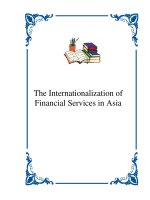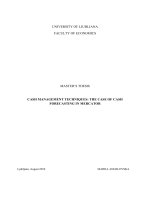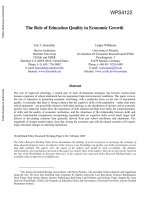The function of TOM1 l1 in bridging EGFR signaling and endocytosis
Bạn đang xem bản rút gọn của tài liệu. Xem và tải ngay bản đầy đủ của tài liệu tại đây (2.64 MB, 166 trang )
THE FUNCTION OF TOM1-L1 IN BRIDGING
EGFR SIGNALING AND ENDOCYTOSIS
LIU NINGSHENG
INSTITUTE OF MOLECULAR AND CELL BIOLOGY
NATIONAL UNIVERSITY OF SINGAPORE
2007
THE FUNCTION OF TOM1-L1 IN BRIDGING
EGFR SIGNALING AND ENDOCYTOSIS
LIU NINGSHENG
(M.Med. Southeast Univ.)
A THESIS SUBMITTED
FOR THE DEGREE OF DOCTOR OF PHILOSOPHY
INSTITUTE OF MOLECULAR AND CELL BIOLOGY
NATIONAL UNIVERSITY OF SINGAPORE
2007
i
Acknowledgements
I would like to express my gratitude to all those who gave me the possibility to
complete this thesis.
My foremost thank goes to my supervisor: Prof. Hong Wanjin, for his patience and
encouragement that carried me on through difficult times, and for his insights and
suggestions that helped to shape my research skills. His valuable feedback contributed
greatly to this dissertation.
My committee members: Assoc. Prof. Cai Minjie and Assoc. Prof. Hunziker
Walter, for their stimulating discussion and critique during my annual committee
meeting. Their valuable feedback helped me to improve the dissertation in many
ways.
My past and present lab members: Dr. Seet Li Fong who introduced and helped me
to start my graduate student life in Molecular and Cell Biology Science by teaching
me molecular, cell biological and biochemical techniques without reservations. Her
visionary thoughts and energetic working style have influenced me greatly as a
biology scientist. Dr. Seet Li Fong, Dr. Loh Eva, Dr. Lim Kah Pang, Dr. Tham
Jill, Dr. Lu Lei and Miss Ong Yan Shan for critical and careful reading of this thesis.
Miss Ong Yan Shan for collaboration in High-Performance Liquid Chromatography
(HPLC) in Figure 3.1. Dr. Tham Jill, Dr. Chan Siew Wee, Dr. Loh Eva, Miss Ong
ii
Yan Shan, Miss Tran Thi Ton Hoai, Dr. Wang Tuanlao and Mr. Li Hongyu for
sharing critical reagents for this study.
I thank all the students and staffs in IMCB who gave me the possibility to complete
this thesis. My appreciation also goes to the DNA sequencing and protein
mass-spectrum unit of IMCB for their excellent services.
Last but not least, I thank my grandparents, and my parents for always being there
when I needed them most, and for supporting me through all these years.
Liu Ningsheng
2007
iii
Table of Contents
Summary
List of Tables
List of Figures
Abbreviations
Chapter 1 Introduction
1.1. Epidermal Growth Factor Receptor (EGFR)
1.1.1 EGFR Structure
1.1.2 Dimerization and Activation
1.1.3 Shc, Grb2 and the Ras/MAPK Pathway
1.1.3.1 Grb2 (Growth Factor Receptor-bound Protein 2)
1.1.3.2 The Src Family Kinase (SFK)
1.2. Endocytosis
1.2.1 The Classical Clathrin-dependent Endocytic Pathway
1.2.2 The Non-classical Clathrin-independent Endocytosis Pathway
1.2.3 EGFR and Lipid Raft
1.2.4 EGFR Sorting and Clathrin-dependent Endocytosis
1.2.5 EGFR Signaling during Trafficking
1.2.6 Ubiquitination and MVB Generation
1.3. TOM1 (Target
of the Oncogene v-Myb 1) Family
1.4. Rational of this work
Chapter 2 Materials and Methods
iv
2.1 cDNA Cloning and Sequencing
2.2 Plasmid Constructs
2.2.1 HA-TOM1-L1, HA-TOM1-L1 Y460F and GFP-TOM1-L1
2.2.2 HA-TOM1-L1 SH3, HA-TOM1-L1 Y392F and HA-TOM1-L1 Y460F & SH3
2.2.3 HA-TOM1-L1-PX and HA-TOM1-L1-PX FDPL450AAAA
2.2.4 GST-TOM1-L1 286-476 and other GST Deletion Constructs (316-476, 360-476,
384-476, 420-476,286-446,286-449,286-440)
2.2.5 GST-TOM1-L1 286-476 LPPL424AAAA, GST-TOM1-L1 286-476 HPAM431
AAAA, GST-TOM1-L1 286-476 DLQP438AAAA and GST-TOM1-L1 286-476
FDPL450AAAA
2.2.6 TOM1, m-TOM1-L1, m-TOM1-L1 Y392F, m-TOM1-L1 Y457F, m-TOM1-L1
DLQP437AAAA and m-TOM1-L1 FDLP449AAAA
2.3 Purification of GST-fusion Proteins
2.4 Immunization of Rabbits and Affinity Purification of Antibodies
2.5 Antibodies
2.6 Cell Culture
2.7 Transient and Stable Expression
2.8 Retroviral Infection
2.9 siRNA knockdown
2.10 EGF, PDGF-bb, or FGF2 Stimulation
2.11 EGF internalisation
2.12 Immunoprecipitation and Western Blot
2.13 Indirect Immunoflurescence Microscopy
2.14 Cytosol Extract
v
2.15 Gel Fractionating
2.16 Clathrin-Binding Assay
2.17 Cell Surface Biotinylation and Stripping
2.18 Biochemical Subcellular Fractionation
2.19 Ras Activation Assay
2.20 Soft Agar Assay for Colony Formation
Chapter 3 Characterization of Endogenous TOM1-L1 Complex and TOM1-L1
Antibodies
3.1 Endogenous TOM1-L1 is in a ~300 kDa Complex at A431 Cells.
3.2 Specific of anti-TOM1-L1 and anti-p-TOM1-L1.
Chapter 4 TOM1-L1 is Tyrosine Phosphorylated by EGF, PDGF, and FGF via a
Src/Fyn-dependent Pathway
4.1 Tyrosine Phosphorylation of TOM1-L1 by Fyn Mediates its Association with Grb2
and PI3K-p85
4.2 Tyrosine Phosphorylation of TOM1-L1 by Src at the Putative SH2 Binding Site.
4.3 TOM1-L1 is Tyrosine Phosphorylated by EGF via a Src-Dependent Pathway and
Important for Interaction with Grb2.
4.4 TOM1-L1 is also Tyrosine Phosphorylated by PDGF and FGF via a Src-Dependent
Pathway.
Chapter 5 TOM1-L1 Mediates the Endocytosis of EGFR
5.1 EGF-Stimulated Tyr-Phosphorylation of TOM1-L1 is Transient and Correlates with
its Transient Interaction with EGFR.
5.2 Endogenous Localisation of TOM1-L1.
5.3 Temporal Correlation between the Association of TOM1-L1 with Cellular
Membranes and EGF Stimulation of A431 Cells.
5.4 TOM1-L1 is Recruited to EGF Receptor-containing Early Endosomes in response to
vi
EGF.
5.5 Mutant Forms of TOM1-L1 Defective in Tyr-Phosphorylation or Interaction with
Grb2 Inhibit Endocytosis of EGFR.
5.6 siRNA-Mediated Knockdown of TOM1-L1 Inhibits Endocytosis of EGFR.
Chapter 6 The C-Terminal Tail of Tom1L1 Harbors a Novel Clathrin- Interacting Motif
Important for Mediating EGFR Endocytosis
6.1 The C-terminal Tail of TOM1-L1 Harbors a Novel Clathrin-interacting Motif.
6.2 TOM1-L1’s Clathrin Binding Motif is Important for its Role in Mediating EGFR
Endocytosis.
6.3 Effect of Depletion of AP2, Clathrin, Cbl, Grb2 or TOM1-L1 on EGFR and TfnR
Endocytosis.
Chapter 7 TOM1-L1 Interacts with Ubiquitin, Hrs and STAM, and Mediates
Degradation of EGFR
7.1 TOM1 Family Proteins Interact with ubiquitin.
7.2 TOM1-L1 Interacts with Hrs, STAM.
7.3 Hrs Recruits TOM1-L1 to Endosomes.
7.4 Knockdown of both TOM1-L1 and Hrs further Delays EGFR degradation.
Chapter 8 TOM1-L1 is a Negative Regulator in Src Kinase Signaling
8.1 TOM1-L1 Inhibits the Activation of Ras upon EGF Stimulation.
8.2 TOM1-L1 Inhibits the Colony Formation in A431 Cells.
Chapter 9 Discussion
Chapter 10 Conclusion and future perspectives
References
vii
SUMMARY
The molecular mechanism governing ligand-stimulated endocytosis of receptor
tyrosine kinases remains elusive. I show here that EGF stimulates transient
tyrosine-phosphorylation of TOM1-L1(TOM-Like 1) by the Src family kinases,
resulting in its transient interaction with the activated EGF (Epidermal Gowth Factor)
receptor (EGFR) bridged by the receptor-bound Grb2 (Growth Factor
Receptor-Bound protein 2). Cytosolic TOM1-L1 is recruited onto the plasma
membrane and subsequently redistributes with EGFR into the early endosome.
Mutant forms of TOM1-L1 defective in tyrosine-phosphorylation or interaction with
Grb2 is incapable of interaction with EGFR and inhibits endocytosis of EGFR. In
addition, siRNA (small interference RNA)-mediated knockdown of TOM1-L1 inhibits
endocytosis of EGFR. The C-terminal tail of TOM1-L1 contains a novel
clathrin-interacting motif, which is important for exogenous TOM1-L1 to rescue
endocytosis of EGFR in TOM1-L1 knocked-down cells. These results suggest that
EGF triggers a transient association of EGFR with TOM1-L1 to engage the endocytic
machinery for endocytosis of the ligand-receptor complex. Moreover, TOM1-L1
interacts with ubiquitin and ESCRT (Endosomal Sorting Complex
Required for
Transport) family proteins, such as: Hrs (Hepatocyte growth factor Receptor tyrosine
kinase Substrate), TSG101 (Tumor Susceptibility Gene 101), STAM1/2 (Signal
Transuding Adaptor Molecule 1/2), and it is recruited to endosome upon
over-expression HA-Hrs. These results suggest that TOM1-L1 could participate in the
machinery for EGFR sorting and degradation. In addition, TOM1-L1 negatively
viii
regulates Ras activation upon EGF stimulation and A431 colony formation, which
indicate that it may play a negative role in Src kinase signaling.
ix
List of Tables
Table 1: Signaling Proteins Recruited to Preferred Docking Sites on the EGFR
Table 2: Phosphatidylinositol (4,5)-bisphoate (PtdIns (4,5)P2) Binding Domains
found in Clathrin Adaptor Proteins
Table 3: List of DNA Plasmid Constructs Made for this Study
x
List of Figures
Figure 1.1 Domain Organization of EGF Receptor
Figure 1.2 Domain Organization of Grb2
Figure 1.3 Domain Organization of Src
Figure 1.4 Clathrin Pathway
Figure 1.5 EGFR Endocytic Pathways
Figure 1.6 ESCRTs components
Figure 1.7 Domain Organization of Hrs, STAM and TSG101.
Figure 1.8 TOM1-L1
Figure 3.1 Endogenous TOM1-L1 is in a ~300 kDa Complex.
Figure 3.2 Characterizations of TOM1-1L1 Antibodies.
Figure 4.1 Tyrosine Phosphorylation of TOM1-L1 by Fyn is Required for its
Interaction with Grb2 and PI3K p85.
Figure 4.2 Tyrosine Phosphorylation of TOM1-L1 by Src at the Putative SH2 Binding
Site.
Figure 4.3 TOM1-L1 is Tyrosine Phosphorylated by EGF via a Src-Dependent
Pathway and Important for Interaction with Grb2.
Figure 4.4 TOM1-L1 is also Tyrosine Phosphorylated by PDGF and FGF via a
Src-Dependent Pathway.
Figure 5.1 EGF Stimulates Transient Association of Tyr-phosphorylated TOM1-L1
with Activated EGFR via Grb2.
Figure 5.2 Endogenous TOM1-L1 is Primarily Cytosolic.
Figure 5.3 Temporal Correlation Between the Association of TOM1-L1 with Cellular
Membranes and EGF Stimulation of A431 Cells.
Figure 5.4 TOM1-L1 is Recruited to EGF Receptor-Containing Early Endosomes in
xi
Response to EGF.
Figure 5.5 TOM1-L1 Mutants Delay Degradation of EGF and EGFR.
Figure 5.6 Mutant TOM1-L1 Delayed EGF-Induced Endocytosis of EGFR.
Figure 5.7 Knockdown of TOM1-L1 Delayed EGF-Induced Degradation and
Endocytosis of EGFR.
Figure 6.1 TOM1-L1 Contains a Novel Clathrin-Binding Motif.
Figure 6.2 TOM1-L1’s Clathrin Binding Motif is Important for its Role in Mediating
EGFR Endocytosis.
Figure 6.3 Effects of Protein Depletion on EGFR and TfnR Endocytosis.
Figure 7.1 TOM1 Family Interacts with Ubiquitin.
Figure 7.2 TOM1-L1 Interacts with Hrs, STAM.
Figure 7.3 Effect of Overexpression of HA-tagged Hrs on Endosomes and TOM1-L1
Licalization Analyized by Immunoflurescence microscpy.
Figure 7.4 Simultaneous Knockdown of Both TOM1-L1 and Hrs Causes a Delay in
EGFR Greater than Knockdown of either TOM1-L1 or Hrs Alone.
Figure 8.1 TOM1-L1 Inhibits the Activation of Ras upon EGF Stimulation.
Figure 8.2 TOM1-L1 inhibits the Colony Formation in A431 Cells.
Figure 9.1 A Proposed Model for TOM1-L1 As a Regulated Adaptor Mediating
EGF-Stimulated Endocytosis of EGFR.
xii
Abbreviations
AP-1/2/3/4: adaptor protein-1/2/3/4
ARF: ADP-ribosylaton factor
ATP: adenosine 5’-triphosphate
BLAST: Basic Local Alignment Search Tool
BSA: bovine serum albumin
CCP: clathrin-coated pit
CCV: clathrin-coated vesicle
CHC: clathrin heavy chain
CIAP: Calf Intestinal Alkaline Phosphotase
CME: clathrin-mediated endocytosis
DME: Dulbecco’s modified eagles (medium)
DMP: dimethyl pimelidate
DTT: dithiothreitol
DUB: deubiquitinating enzymes
EGFR: Epidermal Growth Factor Receptor
ENTH domain: Epsin N-terminal Homology) domain
ErbB (EGFR): originally named because of their homology to the erythroblastoma
viral gene product, v-erbB
ESCRT: Endosomal Sorting
Complexes Required for Transport
FAK: Focal Adhesion Kinase
FGF: Fibroblast growth factor
FITC: Fluorescein Isothiocyanate
xiii
GAT domain: GGA and TOM1 domain
GDP: Guanosine Diphosphate
GEF: Guanine Nucleotide Exchange Factor
GGA1/2/3: Golgi-associated γ-adaptin ear homology, ARF binding protein 1/2/3
GM1: Monosialotetrahexosylganglioside
GPI : Glycosylphosphatidylinositol
Grb2: Growth factor Receptor-Bound Protein 2
GST: Glutathione-S-Transferase
GDP: Guanosine 5’-Diphosphate
GTP: Guanosine 5’-Triphosphate
HA: Hemagglutinin
HEPES: N-2-hydroethylpiperizine-N’-2-ethanesulfonic acid
HPLC: High-Performance Liquid Chromatography
Hrs: Hepatocyte Growth Factor-Regulated Substrate
IF: Immunofluorescence
IP: Immunoprecipitation
IPTG: Isopropyl β-D-thiogalactopyranoside
kD: kilo Dalton
M6PR: Mannose-6-phosphate receptor
Mab: Monoclonal antibody
MAPK: Mitogen-Activated Protein Kinase
MCS: Multiple Cloning Site
xiv
ml: milliliter
mM :millimolar
mg: milligram
MVB: Multivesicular Body
ONPG: O-Nitrophenyl β-D-Galactopyranoside
OD: Optical Density
PA: Phosphatidic Acid
PAGE: Poly-Acrylamide Gel Electrophoresis
PCR: Polymerase Chain Reaction
PDGF: Platelet-Derived Growth Factor
Pfu: Pyrococcus furiosus
PKC: Protein Kinase C
PI3K: Phosphoinositide 3-Kinase
PIP3: Phosphatidylinositol-3,4,5-trisphosphate
PLCγ: Phospholipase C-γ
PLD: Phospholipidase D
PM: Plasma Membrane
PMSF: Phenyl-Methyl-Sulfanyl Fluoride
PI4,5P
2
: Phosphatidylinositol 4,5-bisphosphate
PTB domain: Phosphotyrosine-Binding domain
PtdIns3P: PtdIns-3-phosphate
PTK: Protein Tyrosine Kinase
PVC: Pre-Vacuolar Compartment
xv
PX: Phox (homology domain)
Ras: Rat Sarcoma
RNAi: RNA interference
RPMI: Roswell Park Memorial Institute
RTK: Receptor Tyrosine Kinase
SDS: Sodium Dodecyl Sulfate
SFK: Src Family Kianses
siRNA: small interference RNA
SH2 domain: Src Homology 2 domain
SH3 domain: Src Homology 3 domain
SNARE: SNAP Receptor
SOS: Son of Sevenless
SRP: Signal Recognition Particle
STAM: Signal-Transducing Adaptor Molecule
STAT: Signal Transducers and Activators of Transcription
TfnR: Transferrin Receptor
TGFα: Transforming Growth Factor-α
TGN: Trans-Golgi Network
TOM1: Target
of the Oncogene v-myb
TOM1-L1:TOM1-Like 1
TSG101: Tumor Susceptibility Gene 101
VHS domain: Vps27p, Hrs and STAM domain
xvi
Vps: Vacuolar Protein Sorting
UEV domain: Ubiquitin E2 Variant domain
UIM: Ubiquitin-Interacting Module
XDP: Xanthine Diphosphate
XTP: Xanthine Triphosphate
µM: micromolar
µl: microliter
1
Chapter 1 Introduction
1.1 Epidermal Growth Factor Receptor (EGFR)
The epidermal growth factor (EGF) receptor is a 1186-residue (170kDa)
transmembrane tyrosine kinase, and belongs to the HER/ErbB family (originally
named because of their homology to the erythroblastoma viral gene product, v-erbB).
The EGFR can be activated by 7 types of structurally related growth factors by
transferring the γ-phosphate of bound ATP to the tyrosine residues of the exogenous
substrates and C-terminal domains of the EGFR (in a trans-phosphorylation manner).
EGFR mediates proliferation, survival, and differentiation in mammalian cells (Oda,
et al., 2005), which ultimately activates several signaling pathways. For example,
classical Mitogen-Activated Protein Kinase (MAPK, originally called "Extracellular
Signal-Regulated Kinase, Erk") is activated by the appropriate adaptor or signaling
molecules that recognize EGFR C-terminal phosphotyrosine. During this process,
activated EGFR is also endocytosed from the plasma membrane. Some of the EGFR
are internalized through the fast clathrin-dependent pathway, while others through the
slow clathrin-independent pathway (Le Roy and Wrana, 2005). After internalization,
EGFR is transported to the early endosome, sorted at the MVB (multivesicular body),
fused with the lysosome and ultimately subjected to degradation.
2
1.1.1 EGFR Structure
All ErbB family receptors including the EGFR compose type I transmembrane
proteins that are glycosylated and have disulfide-bonds in their ectodomains, which
are required for membrane location and ligand-binding. They have a single
transmembrane domain and a large cytoplasmic region that contains a tyrosine kinase
and multiple phosphorylation sites (Slieker et al., 1986). The structure of the mature
EGFR (ErbB1) receptor is represented as below.
Figure 1.1 Domain Organization of EGF Receptor.
Abbreviations: I and III: ligand binding domains; II and IV: cysteine-rich domains; TM:
transmembrane domain; JM: juxtamembrane domain which undergoes extensive
co-translational (N-glycosylation) or post-translational modifications (phosphorylation and
ubiquitination); n-lobe and c-lobe: kinase domain; CT: the carboxy-terminal terminal
containing all known auto-phorylation sites. (Adapted from Linggi and Carpenter, 2006. )
The C-terminal domain of the EGFR contains the phosphotyrosine residues that
modulate EGFR-mediated signal transduction. These residues are shown in Table 1.
On the other hand, phosphorylation of the EGFR at specific serine/threonine residues
attenuates its kinase activity. EGFR carboxy-terminal residues Ser
1046
and Ser
1047
are
phosphorylated by CaM kinase II; mutations to either of these residues upregulate
EGFR tyrosine autokinase activity (den Hartigh et al., 1992).
3
Table 1 Signaling Proteins Recruited to Preferred Docking Sites on the EGFR
Phosphorylation site Effector Effector’s binding motif
Tyr 891 c-Src SH2
Tyr 920 c-Src SH2
Tyr 992 PLC-γ C-SH2
PTB-1B
Tyr 1068 Grb2 SH2
Tyr 1086 Grb2 SH2
Dok-R
Abl
Tyr 1148 Shc PTB
PTB-1B
Tyr 1173 Shc PTB
PLC-γ N-SH2
SHP-1
(Adapted from Linggi and Carpenter, 2006.)
1.1.2 Dimerization and Activation
Ligand-induced EGFR dimerization activates the tyrosine kinase domains. The
process of dimerization is necessary, but not sufficient for its intracellular kinase
activation (Domagala et al., 2000; Moriki et al., 2001). Data on deletion mutants have
indicated that the ectodomain, and in particular its domains I and II, play an active
role in preventing kinase activation. While the tyrosine kinase domain residues
835-918 are necessary for dimerization independent of ligand, EGFR does not require
phosphorylation of its kinase activation loop for full enzymatic activity. Ligand
binding increases the proportion of dimerized EGFR, the reorientation of the kinase
domains and the affinity for ATP binding. This enhanced kinase activity is likely due
to its conformational changes (Cho et al., 2002, Humphrey et al., 1988, Yamazaki et
al., 1988, Malden et al., 1988, Berezov et al., 2002).
4
EGFR C-terminus can be autophosphorylated on five tyrosines or
transphosphorylated by other kinases such as Src and Jak-2. Activated EGFR interacts
with the SH2 (Src Homology 2) or PTB (Phosphotyrosine-Binding) domains of
intracellular signal transducers and adaptors, causing their colocalization and the
assembly of multicomponent signaling “particles” (Tice et al., 1999, Yamauchi et al.,
1997). SH2 or PTB domain-mediated interaction of intracellular-proteins with EGFR
is dependent on their phosphorylation state of key tyrosine residues. Whereas some
other proteins such as ZPR-1 (Zinc Finger Protein 1) and STAT (Signal Transducers
and Activators of Transcription) transcription factors interact with EGFR in their
unphosphorylated state and are activated or translocated to other cellular location
upon ligand stimulation (Galcheva-Gargova et al., 1996, Xia et al., 2002, Olayioye et
al., 1999).
The C-terminal truncated EGFR alone is enough to stimulate the normal EGFR
signaling pathway (Walker et al., 1998, Wong et al., 1999). Signaling proteins
associate directly interacting with EGFR C-terminal scaffold or indirectly via adaptor
molecules (Stover et al., 1995, Lowenstein et al., 1992).
5
1.1.3 Shc, Grb2 and the Ras/MAPK Pathway
A well studied pathway activated by EGFR is the classic EGFR-Shc (Src
Homologous and Collagen)-Grb2 (Growth Factor Receptor-bound Protein 2)-
Ras/MAPK pathway, which starts from the proto-oncogene Ras and ends with the
serine/threonine kinase MAPK. Grb2 is the key adaptor in this pathway (Lowenstein
et al., 1992). Grb2 interacts with FAK, dynamin (cytoskeletal reorganization), Cbl,
Dab-2(Disabled-2), SOCS-1(Suppressor of Cytokine Signaling proteins-1), and SHIP
(Src Homology 2 domain-containing Inositol Phosphatase). Grb2 binds constitutively
to the Ras exchange factor Sos (Son Of Sevenless
) and is localized to the cytosol.
Upon EGFR stimulation and phosphorylation, Grb2 can interact with EGFR by
binding either directly via EGFR Y
1068
and Y
1086
or indirectly via Shc.
Shc is EGFR-associated, and tyrosine phosphorylated by EGFR (Batzer et al., 1994,
Sasaoka et al., 1994, Sakaguchi et al., 1998, Sato et al., 2002). It contains SH2 and
PTB domains that associate with tyrosine-phosphorylated domains such as
MEKK-1(MAPK kinase kinase-1) and cadherin (Meisner et al., 1995, Schlaepfer et
al., 1999, Xu et al., 1998, De Sepulveda et al., 1999, Harmer et al., 1999, Pelicci et al.,
1995, Xu et al., 1997 ). However Shc’s function is still unclear (Hashimoto et al.,
1999).
The interaction of the membrane-associated Ras with Sos is increased by recruiting
the Grb2/Sos complex to EGFR at the plasma membrane. This leads to the exchange
6
of GDP-Ras for GTP-Ras and the activation of Ras. Ras activation subsequently
activates serine/threonine kinase Raf-1, which eventually phosphorylates, activates
and promotes the nuclear translocation of Erk-1 (Extracellular Signal-regulated
Kinase 1) and Erk2 (Extracellular Signal-regulated Kinase 2) via a series of the
intermediate kinases (Di Guglielmo et al., 1994).
1.1.3.1 Grb2 (Growth Factor Receptor-bound Protein 2)
Figure 1.2 Domain Organization of Grb2
Abbreviations: SH3: Src Homology 3 domain; SH2: Src Homology 2 domain
Grb2 is a small 25kDa (217 aa) protein, which contains: two SH3 domains. One is at
the N-terminal and the other is at the C-terminal, with a SH2 domain in the middle
(Chardin et al., 1995). Two long flexible arms (or linkers) lie between the SH2 and
C-terminal SH3 domains. Data on the X-ray crystal of Grb2 shows a rather weak
interaction between the two SH3 domains and the flexible linker
region. This enables the SH3 domains to associate and recognize multiple targets with
diversely spaced proline rich motif (Downward, 1994).
Grb2 interacts with phosphorylated receptors to associate RTK (Receptor Tyrosine
Kinase) with activation of the Ras pathway. The SH3 domains of Grb2 can also bind
directly to Cbl. In mammalian cells, Grb2 can indirectly recruit Cbl to EGFR or Met
7
receptors. Cbl can directly interact with specific residues in autophosphorylated
receptors through its SH2 domain (Waterman et al., 2002; Peschard et al., 2003). This
bivalent binding module may be critical for receptor-mediated phosphorylation of Cbl
(via association with Grb2) or Cbl-induced ubiquitinations of receptors (via direct
association of Cbl with RTKs) (Yoon et al., 1995, De Sepulveda et al., 1999). Grb2
activates Ras/MAPK signaling pathway via Sos. On the other hand it also promotes
the ubiquitination and endocytosis of receptors through recruiting the Cbl-CIN85
(Cbl-interacting protein of 85 kDa)-endophilin (End) complex, and binding to Sprouty,
SHIPs, SOCS and Ack, which further attenuates the receptor signaling pathways
(Schlaepfer et al., 1999, Xu et al., 1998, De Sepulveda, et al., 1999, Harmer and
DeFranco, 1999). Thus, Grb2 plays a bridging role of integrating both positive and
negative signaling pathways. It is quite interesting to understand how the cell
regulates such interactions. These interactions are dependent on the different affinity
and the relative concentrations of these proteins (Damelin and Silver, 2000).
1.1.3.2 The Src Family Kinase (SFK)
Figure 1.3 Domain Organization of Src
Abbreviations: M: the Membrane-binding domain; U: Unique domain; SH3: Src Homology 3
domain; SH2: Src Homology 2 domain; L: linker; catalytic domain and R: Regulatory
domains. (Adapted from Martin GS, 2001)









